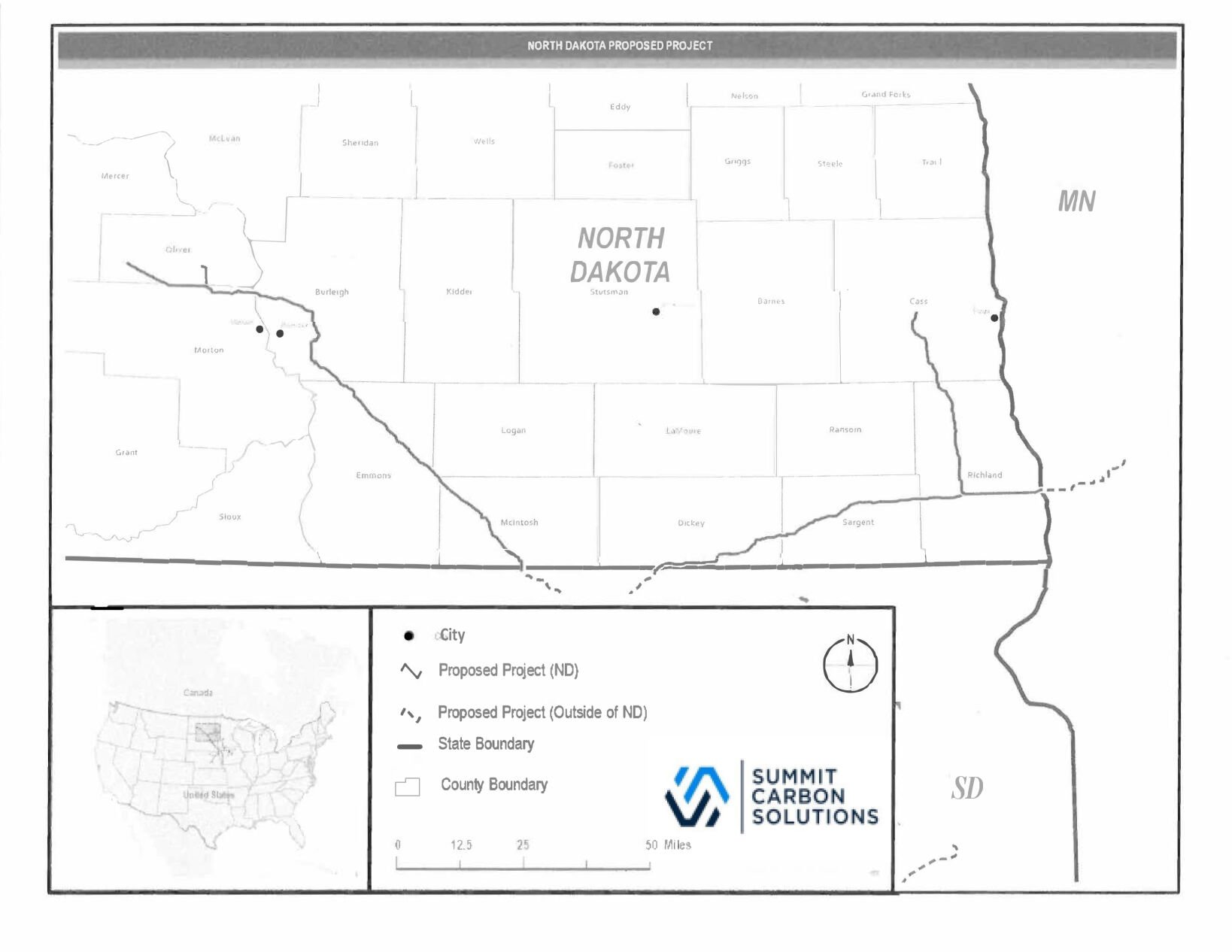“This is only about this project, in this location, under these circumstances,” Public Service Commission Chair Randy Christmann said after the PSC issued its decision Aug. 4.
The denial was not routine for a commission that sees 15-20 applications for pipelines of various sizes every year. PSC Director of Public Utilities Victor Schock said he is not aware of any other pipelines that have been rejected in his nine years working for the commission.
 “It’s absolutely not the norm,” he said.
“It’s absolutely not the norm,” he said.
The commission cited several reasons for its decision, including that Summit had not adequately addressed how the project would impact sensitive areas including cultural sites, some wildlife areas and unstable geological areas. The PSC in its order also said that Summit “has not taken the steps to address outstanding legitimate impacts expressed by landowners during the public comment or demonstrated why a reroute is not feasible.”
People are also reading…
Iowa-based Summit previously said it planned to reapply and address the issues brought by the PSC. But Summit on Friday submitted a petition for reconsideration of the PSC’s Aug. 4 decision. The request presents numerous route adjustments and asks for a one-day hearing for witness testimony in support of its new plans.
If the PSC does not accept Summit’s motion for reconsideration and Summit has to reapply, another application process, upcoming new federal regulations and legal questions over where CO2 will be stored paints a picture of a long wait until construction can begin.
But Summit Executive Vice President Wade Boeshans said he does not believe the PSC decision “has a material impact on the overall schedule.”
Summit has said previously it expects the pipeline to be operational in 2024.
<imgsrc=”https://sdpropertyrights.com/wp-content/uploads/2023/08/Summit-wants-pipeline-route-rejection-reconsidered-faces-long-road-if-it-has-to-reappl-10.jpg” alt=”Summit ND route.jpg” class=”img-responsive lazyload full default” width=”1638″ height=”1266″ data-sizes=”auto” data-srcset=”https://sdpropertyrights.com/wp-content/uploads/2023/08/Summit-wants-pipeline-route-rejection-reconsidered-faces-long-road-if-it-has-to-reappl-10.jpg?resize=150%2C116 150w, https://sdpropertyrights.com/wp-content/uploads/2023/08/Summit-wants-pipeline-route-rejection-reconsidered-faces-long-road-if-it-has-to-reappl-10.jpg?resize=200%2C155 200w, https://sdpropertyrights.com/wp-content/uploads/2023/08/Summit-wants-pipeline-route-rejection-reconsidered-faces-long-road-if-it-has-to-reappl-10.jpg?resize=225%2C174 225w, https://sdpropertyrights.com/wp-content/uploads/2023/08/Summit-wants-pipeline-route-rejection-reconsidered-faces-long-road-if-it-has-to-reappl-10.jpg?resize=300%2C232 300w, https://sdpropertyrights.com/wp-content/uploads/2023/08/Summit-wants-pipeline-route-rejection-reconsidered-faces-long-road-if-it-has-to-reappl-10.jpg?resize=400%2C309 400w, https://sdpropertyrights.com/wp-content/uploads/2023/08/Summit-wants-pipeline-route-rejection-reconsidered-faces-long-road-if-it-has-to-reappl-10.jpg?resize=540%2C417 540w, https://sdpropertyrights.com/wp-content/uploads/2023/08/Summit-wants-pipeline-route-rejection-reconsidered-faces-long-road-if-it-has-to-reappl-10.jpg?resize=640%2C495 640w, https://sdpropertyrights.com/wp-content/uploads/2023/08/Summit-wants-pipeline-route-rejection-reconsidered-faces-long-road-if-it-has-to-reappl-10.jpg?resize=750%2C580 750w, https://sdpropertyrights.com/wp-content/uploads/2023/08/Summit-wants-pipeline-route-rejection-reconsidered-faces-long-road-if-it-has-to-reappl-10.jpg?resize=990%2C765 990w, https://sdpropertyrights.com/wp-content/uploads/2023/08/Summit-wants-pipeline-route-rejection-reconsidered-faces-long-road-if-it-has-to-reappl-10.jpg?resize=1035%2C800 1035w, https://sdpropertyrights.com/wp-content/uploads/2023/08/Summit-wants-pipeline-route-rejection-reconsidered-faces-long-road-if-it-has-to-reappl-10.jpg?resize=1200%2C927 1200w, https://sdpropertyrights.com/wp-content/uploads/2023/08/Summit-wants-pipeline-route-rejection-reconsidered-faces-long-road-if-it-has-to-reappl-10.jpg?resize=1333%2C1030 1333w, https://sdpropertyrights.com/wp-content/uploads/2023/08/Summit-wants-pipeline-route-rejection-reconsidered-faces-long-road-if-it-has-to-reappl-10.jpg?resize=1476%2C1141 1476w, https://sdpropertyrights.com/wp-content/uploads/2023/08/Summit-wants-pipeline-route-rejection-reconsidered-faces-long-road-if-it-has-to-reappl-10.jpg 2008w”/>
A lengthy process
The Midwest Carbon Express pipeline is to move CO2 emissions from dozens of ethanol plants in Nebraska, Iowa, the Dakotas and Minnesota and to western North Dakota’s Oliver County for permanent storage underground. The 320-mile route in North Dakota that the PSC rejected was to pass through Burleigh, Cass, Dickey, Emmons, Logan, McIntosh, Morton, Oliver, Richland and Sargent counties.
Summit submitted its siting application to the PSC in October 2022. The process entailed filing numerous forms, addressing the concerns of intervenors and attending five PSC public hearings held across the state.
This is a process that will have to begin again if Summit has to reapply.
The prior application took about 10 months to work its way through the process. Schock expects a similar timeline for any reapplication.
If Summit hopes to be approved it needs to properly address every issue the commission brought up in its order, according to Schock.
At a sparsely attended public open house that Summit held Monday to demonstrate the project’s safety, multiple company representatives attributed the route rejection to not enough communication from Summit with the PSC and landowners. They maintained that the company had the ability to, and would, address the concerns of all stakeholders.
Hearings for the project are set to begin later this month in Iowa and in September in South Dakota. Minnesota is in the midst of its permitting process. Nebraska does not have statewide regulations pertaining to CO2 pipelines but counties can enact local ordinances.
<imgsrc=”https://sdpropertyrights.com/wp-content/uploads/2023/08/Summit-wants-pipeline-route-rejection-reconsidered-faces-long-road-if-it-has-to-reappl-11.jpg” alt=”060323-nws-hearing1.jpg (copy)” class=”img-responsive lazyload full default” width=”1876″ height=”1105″ data-sizes=”auto” data-srcset=”https://bloximages.chicago2.vip.townnews.com/bismarcktribune.com/content/tncms/assets/v3/editorial/7/72/772e0e2a-0c67-11ee-8fd4-5f62fc451f03/647a20ebe90d7.image.jpg?resize=150%2C88 150w, https://bloximages.chicago2.vip.townnews.com/bismarcktribune.com/content/tncms/assets/v3/editorial/7/72/772e0e2a-0c67-11ee-8fd4-5f62fc451f03/647a20ebe90d7.image.jpg?resize=200%2C118 200w, https://bloximages.chicago2.vip.townnews.com/bismarcktribune.com/content/tncms/assets/v3/editorial/7/72/772e0e2a-0c67-11ee-8fd4-5f62fc451f03/647a20ebe90d7.image.jpg?resize=225%2C133 225w, https://bloximages.chicago2.vip.townnews.com/bismarcktribune.com/content/tncms/assets/v3/editorial/7/72/772e0e2a-0c67-11ee-8fd4-5f62fc451f03/647a20ebe90d7.image.jpg?resize=300%2C177 300w, https://bloximages.chicago2.vip.townnews.com/bismarcktribune.com/content/tncms/assets/v3/editorial/7/72/772e0e2a-0c67-11ee-8fd4-5f62fc451f03/647a20ebe90d7.image.jpg?resize=400%2C236 400w, https://bloximages.chicago2.vip.townnews.com/bismarcktribune.com/content/tncms/assets/v3/editorial/7/72/772e0e2a-0c67-11ee-8fd4-5f62fc451f03/647a20ebe90d7.image.jpg?resize=540%2C318 540w, https://bloximages.chicago2.vip.townnews.com/bismarcktribune.com/content/tncms/assets/v3/editorial/7/72/772e0e2a-0c67-11ee-8fd4-5f62fc451f03/647a20ebe90d7.image.jpg?resize=640%2C377 640w, https://bloximages.chicago2.vip.townnews.com/bismarcktribune.com/content/tncms/assets/v3/editorial/7/72/772e0e2a-0c67-11ee-8fd4-5f62fc451f03/647a20ebe90d7.image.jpg?resize=750%2C442 750w, https://bloximages.chicago2.vip.townnews.com/bismarcktribune.com/content/tncms/assets/v3/editorial/7/72/772e0e2a-0c67-11ee-8fd4-5f62fc451f03/647a20ebe90d7.image.jpg?resize=990%2C583 990w, https://bloximages.chicago2.vip.townnews.com/bismarcktribune.com/content/tncms/assets/v3/editorial/7/72/772e0e2a-0c67-11ee-8fd4-5f62fc451f03/647a20ebe90d7.image.jpg?resize=1035%2C610 1035w, https://bloximages.chicago2.vip.townnews.com/bismarcktribune.com/content/tncms/assets/v3/editorial/7/72/772e0e2a-0c67-11ee-8fd4-5f62fc451f03/647a20ebe90d7.image.jpg?resize=1200%2C707 1200w, https://bloximages.chicago2.vip.townnews.com/bismarcktribune.com/content/tncms/assets/v3/editorial/7/72/772e0e2a-0c67-11ee-8fd4-5f62fc451f03/647a20ebe90d7.image.jpg?resize=1333%2C785 1333w, https://bloximages.chicago2.vip.townnews.com/bismarcktribune.com/content/tncms/assets/v3/editorial/7/72/772e0e2a-0c67-11ee-8fd4-5f62fc451f03/647a20ebe90d7.image.jpg?resize=1476%2C869 1476w, https://sdpropertyrights.com/wp-content/uploads/2023/08/Summit-wants-pipeline-route-rejection-reconsidered-faces-long-road-if-it-has-to-reappl-11.jpg 2008w”/>
Reroutes, big and small
Summit must demonstrate that the project poses minimal risk to the environment and the welfare of North Dakota residents to gain PSC approval.
Some form of a reroute likely will be necessary unless the company can prove there are no other options or that it addressed the specific factors the commission took issue with along the initial proposed route, according to Schock.
“They need to present a document or a witness that’s able to be cross-examined,” he said.
Schock said Summit did not provide this for many of the issues under contention in its previous application.
“There were a lot of things where it’s possible that the company already rectified, but it’s not in the record,” he said.
Some changes to the route will be more straightforward than others. The company will have to account for many of the avoidance areas that the PSC expressed concern over — such as those with geological instability highlighted by the state Geological Survey as well as some wildlife management areas.
Boeshans said he could not speak directly to the Tribune regarding these specific issues but that the company is in the process of addressing them with the PSC.
<imgsrc=”https://sdpropertyrights.com/wp-content/uploads/2023/08/Summit-wants-pipeline-route-rejection-reconsidered-faces-long-road-if-it-has-to-reappl-12.jpg” alt=”Wade Boeshans” class=”img-responsive lazyload full default” width=”1200″ height=”1500″ data-sizes=”auto” data-srcset=”https://bloximages.chicago2.vip.townnews.com/bismarcktribune.com/content/tncms/assets/v3/editorial/7/83/78336ff7-4070-5292-9563-76feb528db42/5fa302de7b46c.image.jpg?resize=150%2C188 150w, https://bloximages.chicago2.vip.townnews.com/bismarcktribune.com/content/tncms/assets/v3/editorial/7/83/78336ff7-4070-5292-9563-76feb528db42/5fa302de7b46c.image.jpg?resize=200%2C250 200w, https://bloximages.chicago2.vip.townnews.com/bismarcktribune.com/content/tncms/assets/v3/editorial/7/83/78336ff7-4070-5292-9563-76feb528db42/5fa302de7b46c.image.jpg?resize=225%2C281 225w, https://bloximages.chicago2.vip.townnews.com/bismarcktribune.com/content/tncms/assets/v3/editorial/7/83/78336ff7-4070-5292-9563-76feb528db42/5fa302de7b46c.image.jpg?resize=300%2C375 300w, https://bloximages.chicago2.vip.townnews.com/bismarcktribune.com/content/tncms/assets/v3/editorial/7/83/78336ff7-4070-5292-9563-76feb528db42/5fa302de7b46c.image.jpg?resize=400%2C500 400w, https://bloximages.chicago2.vip.townnews.com/bismarcktribune.com/content/tncms/assets/v3/editorial/7/83/78336ff7-4070-5292-9563-76feb528db42/5fa302de7b46c.image.jpg?resize=540%2C675 540w, https://bloximages.chicago2.vip.townnews.com/bismarcktribune.com/content/tncms/assets/v3/editorial/7/83/78336ff7-4070-5292-9563-76feb528db42/5fa302de7b46c.image.jpg?resize=640%2C800 640w, https://bloximages.chicago2.vip.townnews.com/bismarcktribune.com/content/tncms/assets/v3/editorial/7/83/78336ff7-4070-5292-9563-76feb528db42/5fa302de7b46c.image.jpg?resize=750%2C938 750w, https://bloximages.chicago2.vip.townnews.com/bismarcktribune.com/content/tncms/assets/v3/editorial/7/83/78336ff7-4070-5292-9563-76feb528db42/5fa302de7b46c.image.jpg?resize=990%2C1238 990w, https://bloximages.chicago2.vip.townnews.com/bismarcktribune.com/content/tncms/assets/v3/editorial/7/83/78336ff7-4070-5292-9563-76feb528db42/5fa302de7b46c.image.jpg?resize=1035%2C1294 1035w, https://sdpropertyrights.com/wp-content/uploads/2023/08/Summit-wants-pipeline-route-rejection-reconsidered-faces-long-road-if-it-has-to-reappl-12.jpg 1200w”/>
Other elements of a reroute may be more substantial. The originally proposed route put the pipeline just 2 miles outside of Bismarck’s extraterritorial area at its closest point, sparking concerns that it would impede the city’s growth to the north and east. The commission found that while some intervenors stretched the likelihood of adverse effects on property values, Summit had not adequately minimized these potential impacts.
Summit’s request for reconsideration states those concerns are moot because the company has an alternative route for north of Bismarck that is now 5 miles north of the city’s extraterritorial area.
Summit ruled out a southern Bismarck route after the PSC requested the company analyze one. Summit cited the goal of avoiding Dakota Access Pipeline-type protests along with other geographic and cultural concerns.
Schock said the primary issue with the analysis was that Summit did not sufficiently explain why another route was not feasible. He said the story may have played out differently had the document been submitted to the record for the PSC to cross-examine at a hearing.
Prior to Summit sending in a reconsideration, Boeshans said all potential routes would be back under consideration, including a southern route, but he said pushing the project farther north is preferable. Summit claims in its petition that the issue of a southern route is now moot, given it believes its reroute addresses the north-Bismarck landowners’ concerns, but it is willing to offer a witness to testify to the issues with a southern route.
Standing Rock Sioux Tribal Archeologist Tyrell Iron Eyes testified at a public hearing in June that moving the pipeline route south of Bismarck would place it in treaty territory. That was an issue during the DAPL protests, with Native Americans maintaining the route was on land that was rightfully theirs under an 1851 treaty agreement broken by the U.S. government.
The costs are in the millions for every extra mile of pipeline laid. Crossing new properties also means working to obtain new easement agreements with landowners.
Summit said it has secured easements with 80% of landowners across the route in North Dakota.
Every landowner who has signed an easement agreement has already received the compensation provided for in their contracts, and the landowners will keep the money, according to Boeshans.
<imgsrc=”https://sdpropertyrights.com/wp-content/uploads/2023/08/Summit-wants-pipeline-route-rejection-reconsidered-faces-long-road-if-it-has-to-reappl-13.jpg” alt=”PSC (copy)” class=”img-responsive lazyload full default” width=”1951″ height=”1063″ data-sizes=”auto” data-srcset=”https://sdpropertyrights.com/wp-content/uploads/2023/08/Summit-wants-pipeline-route-rejection-reconsidered-faces-long-road-if-it-has-to-reappl-13.jpg?resize=150%2C82 150w, https://sdpropertyrights.com/wp-content/uploads/2023/08/Summit-wants-pipeline-route-rejection-reconsidered-faces-long-road-if-it-has-to-reappl-13.jpg?resize=200%2C109 200w, https://sdpropertyrights.com/wp-content/uploads/2023/08/Summit-wants-pipeline-route-rejection-reconsidered-faces-long-road-if-it-has-to-reappl-13.jpg?resize=225%2C123 225w, https://sdpropertyrights.com/wp-content/uploads/2023/08/Summit-wants-pipeline-route-rejection-reconsidered-faces-long-road-if-it-has-to-reappl-13.jpg?resize=300%2C163 300w, https://sdpropertyrights.com/wp-content/uploads/2023/08/Summit-wants-pipeline-route-rejection-reconsidered-faces-long-road-if-it-has-to-reappl-13.jpg?resize=400%2C218 400w, https://sdpropertyrights.com/wp-content/uploads/2023/08/Summit-wants-pipeline-route-rejection-reconsidered-faces-long-road-if-it-has-to-reappl-13.jpg?resize=540%2C294 540w, https://sdpropertyrights.com/wp-content/uploads/2023/08/Summit-wants-pipeline-route-rejection-reconsidered-faces-long-road-if-it-has-to-reappl-13.jpg?resize=640%2C349 640w, https://sdpropertyrights.com/wp-content/uploads/2023/08/Summit-wants-pipeline-route-rejection-reconsidered-faces-long-road-if-it-has-to-reappl-13.jpg?resize=750%2C409 750w, https://sdpropertyrights.com/wp-content/uploads/2023/08/Summit-wants-pipeline-route-rejection-reconsidered-faces-long-road-if-it-has-to-reappl-13.jpg?resize=990%2C539 990w, https://sdpropertyrights.com/wp-content/uploads/2023/08/Summit-wants-pipeline-route-rejection-reconsidered-faces-long-road-if-it-has-to-reappl-13.jpg?resize=1035%2C564 1035w, https://sdpropertyrights.com/wp-content/uploads/2023/08/Summit-wants-pipeline-route-rejection-reconsidered-faces-long-road-if-it-has-to-reappl-13.jpg?resize=1200%2C654 1200w, https://sdpropertyrights.com/wp-content/uploads/2023/08/Summit-wants-pipeline-route-rejection-reconsidered-faces-long-road-if-it-has-to-reappl-13.jpg?resize=1333%2C726 1333w, https://sdpropertyrights.com/wp-content/uploads/2023/08/Summit-wants-pipeline-route-rejection-reconsidered-faces-long-road-if-it-has-to-reappl-13.jpg?resize=1476%2C804 1476w, https://sdpropertyrights.com/wp-content/uploads/2023/08/Summit-wants-pipeline-route-rejection-reconsidered-faces-long-road-if-it-has-to-reappl-13.jpg 2008w”/>
New regulations
A new siting application would push the project’s start date closer to when new federal Pipeline and Hazardous Materials Safety Administration regulations regarding CO2 pipelines are expected to be in place. A draft of these is expected in June 2024.
PHMSA regulates pipelines in the U.S. The agency set out to update regulations after a CO2 pipeline operated by Denbury Gulf Coast Pipelines ruptured in 2020 near Satartia, Mississippi, resulting in 45 people seeking hospital care.
Many who expressed opposition to Summit’s siting application in North Dakota pressed the PSC to not approve the project until new regulations were in place. The PSC said compliance with PHMSA regulations are outside of the commission’s jurisdiction.
Boeshans said current regulations will allow for Summit to build a safe pipeline.
“All the root causes of (the Satartia) failure are addressed in the current set of regulations,” he said.
Summit Project Manager Aaron Eldridge said even if there are new PHMSA regulations that the company does not anticipate, pipeline operators have been able to adjust to new standards in the past without upgrading infrastructure.
Boeshans said much of the public’s concern over the project was due to misinformation and misunderstanding about CO2.
“The facts are there’s 5,000 miles of CO2 pipelines operating in the U.S. today, and of all (pipelines) operating in the U.S., CO2 lines have the best safety record,” he said.
Experts say there are different considerations necessary for CO2 pipelines.
CO2 is odorless, colorless and an asphyxiant that displaces oxygen, which can cause breathing problems and hamper emergency responses because most vehicles require oxygen to run. CO2 does not burn, but it is heavier than air, and once a rupture occurs it could spread near the ground undetected.
There is no standard potential impact radius for a CO2 pipeline leak, according to Kenneth Clarkson, spokesman for the watchdog group Pipeline Safety Trust. Since the dissipation and dispersion of CO2 is dependent on geography, weather and atmospheric conditions, it has the potential to spread to a greater area than other types of gases, he said.
The PSC on Aug. 4 denied requests to make Summit’s dispersion model public information, accepting the company’s arguments that the model is a security system plan for critical infrastructure.
Rod Dillon, director of regulatory compliance at Summit, said the company is accounting for all of the safety issues. Summit will utilize an operations control center in Ames, Iowa, that will allow for constant monitoring of the pipeline. This will give operators the ability to remotely shut off valves in 30 seconds, according to Dillon.
He said there also will be continuous monitoring of atmospheric conditions in order to determine where and how far a leak could travel, and that Summit plans to regularly train first responders in every county along the route.
<imgsrc=”https://sdpropertyrights.com/wp-content/uploads/2023/08/Summit-wants-pipeline-route-rejection-reconsidered-faces-long-road-if-it-has-to-reappl-14.jpg” alt=”031523-NWS-PIPELINE-PSC-SUMMIT.jpg (copy)” class=”img-responsive lazyload full default” width=”1633″ height=”1268″ data-sizes=”auto” data-srcset=”https://bloximages.chicago2.vip.townnews.com/bismarcktribune.com/content/tncms/assets/v3/editorial/d/1d/d1de9142-3d3f-11ee-9177-fb9a93b4f076/641095724ac20.image.jpg?resize=150%2C116 150w, https://bloximages.chicago2.vip.townnews.com/bismarcktribune.com/content/tncms/assets/v3/editorial/d/1d/d1de9142-3d3f-11ee-9177-fb9a93b4f076/641095724ac20.image.jpg?resize=200%2C155 200w, https://bloximages.chicago2.vip.townnews.com/bismarcktribune.com/content/tncms/assets/v3/editorial/d/1d/d1de9142-3d3f-11ee-9177-fb9a93b4f076/641095724ac20.image.jpg?resize=225%2C175 225w, https://bloximages.chicago2.vip.townnews.com/bismarcktribune.com/content/tncms/assets/v3/editorial/d/1d/d1de9142-3d3f-11ee-9177-fb9a93b4f076/641095724ac20.image.jpg?resize=300%2C233 300w, https://bloximages.chicago2.vip.townnews.com/bismarcktribune.com/content/tncms/assets/v3/editorial/d/1d/d1de9142-3d3f-11ee-9177-fb9a93b4f076/641095724ac20.image.jpg?resize=400%2C311 400w, https://bloximages.chicago2.vip.townnews.com/bismarcktribune.com/content/tncms/assets/v3/editorial/d/1d/d1de9142-3d3f-11ee-9177-fb9a93b4f076/641095724ac20.image.jpg?resize=540%2C419 540w, https://bloximages.chicago2.vip.townnews.com/bismarcktribune.com/content/tncms/assets/v3/editorial/d/1d/d1de9142-3d3f-11ee-9177-fb9a93b4f076/641095724ac20.image.jpg?resize=640%2C497 640w, https://bloximages.chicago2.vip.townnews.com/bismarcktribune.com/content/tncms/assets/v3/editorial/d/1d/d1de9142-3d3f-11ee-9177-fb9a93b4f076/641095724ac20.image.jpg?resize=750%2C582 750w, https://bloximages.chicago2.vip.townnews.com/bismarcktribune.com/content/tncms/assets/v3/editorial/d/1d/d1de9142-3d3f-11ee-9177-fb9a93b4f076/641095724ac20.image.jpg?resize=990%2C769 990w, https://bloximages.chicago2.vip.townnews.com/bismarcktribune.com/content/tncms/assets/v3/editorial/d/1d/d1de9142-3d3f-11ee-9177-fb9a93b4f076/641095724ac20.image.jpg?resize=1035%2C804 1035w, https://bloximages.chicago2.vip.townnews.com/bismarcktribune.com/content/tncms/assets/v3/editorial/d/1d/d1de9142-3d3f-11ee-9177-fb9a93b4f076/641095724ac20.image.jpg?resize=1200%2C932 1200w, https://bloximages.chicago2.vip.townnews.com/bismarcktribune.com/content/tncms/assets/v3/editorial/d/1d/d1de9142-3d3f-11ee-9177-fb9a93b4f076/641095724ac20.image.jpg?resize=1333%2C1035 1333w, https://bloximages.chicago2.vip.townnews.com/bismarcktribune.com/content/tncms/assets/v3/editorial/d/1d/d1de9142-3d3f-11ee-9177-fb9a93b4f076/641095724ac20.image.jpg?resize=1476%2C1146 1476w, https://sdpropertyrights.com/wp-content/uploads/2023/08/Summit-wants-pipeline-route-rejection-reconsidered-faces-long-road-if-it-has-to-reappl-14.jpg 2008w”/>
Storage snags
A lawsuit brought by a state landowner’s group may create complications for Summit beyond the pipeline.
CO2 storage requires access to small cavities below the ground called pore space, which is the part of the subsurface that is porous enough for liquid and gas to flow through. Summit says it has signed easements with the owners of around 90% of the pore space at the Oliver County site.
The permitting of storage facilities is under the authority of the state Industrial Commission made up of the governor, the attorney general and the agriculture commissioner.
CO2 gas cannot be blocked off from the pore space of one part of a storage facility, so the company needs permission to use all of the pore space in question. If not every pore space owner agrees, the Industrial Commission relies on a process called amalgamation.
North Dakota law says for amalgamation to occur, owners of at least 60% of pore space must consent to easements and the storage facility operator must make a “good-faith effort” to get the consent of all landowners. Those who do not sign easements are to be “equitably compensated.”
The Northwest Landowners Association has filed a lawsuit against the state arguing that amalgamation is a taking of land, and for the state to engage in a taking of land, it must file eminent domain proceedings with landowners. Eminent domain is the taking of private property for public use, with just compensation. This includes hearings to determine what is a “just” compensation.
If the lawsuit is successful, there could be a potential for relitigating certain takings, according to Derrick Braaten, the group’s attorney.
This means that even in the event that Summit is able to acquire a storage facility prior to a decision on the lawsuit, a win by the landowners group may mean the company would have to file eminent domain cases to use the pore space of landowners who don’t sign easements.
Summit filed to intervene in this suit. Basin Electric Power Cooperative and Minnkota Power Cooperative, which respectively operate and plan to operate carbon storage facilities, also intervened.
Separately, Summit signed an agreement in 2022 to co-develop carbon storage facilities in and around Oliver County with Minnkota.
Minnkota is finishing up the process of deciding whether it will go ahead with construction of Project Tundra, which would be the country’s largest CO2 storage project, capturing emissions from the Milton R. Young Station, a coal-fired power plant in Oliver County.
An application for Minnkota’s third storage facility will be headed to the Industrial Commission for approval in the coming months, according to state Mineral Resources Director Lynn Helms.
Minnkota’s application for the facility says the proposed site will be primarily used for CO2 emissions from the Milton R. Young Station, but if there is remaining pore space it will market that to third-party sources.
Boeshans has told the Tribune there are “no firm commitments to deliver CO2 to” the facility.
Reach Joey Harris at 701-250-8252 or joseph.harris@bismarcktribune.com.

